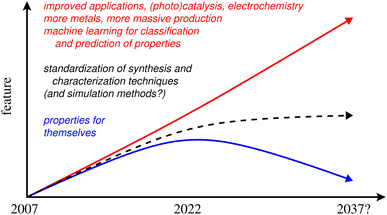 Open Access Article
Open Access ArticleConcluding remarks
Florent
Calvo

Université Grenoble Alpes, CNRS, LiPhy, Grenoble 38000, France. E-mail: florent.calvo@univ-grenoble-alpes.fr
First published on 20th October 2022
Abstract
In 2007 in Birmingham, Riccardo Ferrando, Sarah Horswell, Claude Henry, Brian Johnson, Peter Lievens and the late Roy Johnston, organised a first Faraday Discussions on the topic of nanoparticles made of multiple metals, setting the stage for what would then become known as “nanoalloys”. A second edition of these discussions, held in London in 2022, shows how significantly the field of nanoalloys has evolved in fifteen years.
Progress can be witnessed in multiple directions, ranging from system size and complexity, applications that have become more diverse, or simply more mature. The production of nanoparticles by physical methods based on laser ablation in vacuum or in liquid phases is now complemented by more original techniques using cryogenic environments such as helium droplets. Chemical syntheses now exploit more routine impregnation techniques, narrowing the gap towards industrial applications.
Perhaps a striking evolution in the field relates to characterization tools, as it has become quite common in many groups to quite efficiently combine electronic microscopy (in transmission or reflection, in dark or bright fields), X-ray spectroscopy (including under small or wide angles) and diffraction, photoelectron and optical absorption spectra, together with elemental analyses also based on X-rays. Chromatographic and electrochemical methods such as cyclic voltammetry further provide the quantitative insight needed to characterize the performance of catalysts based on nanoalloys. Such experimental combinations are usually enabled owing to the development of platforms that gather together the various instruments on single academic sites, as well as a broader access to large-scale facilities such as synchrotron sources. Most importantly, many experiments are now carried out under in situ or operando conditions.
On the computational side, progress can be monitored in various directions as well. Unsurprisingly, atomic scale modeling is now addressing larger systems containing hundreds of atoms if electronic structure is described explicitly, or tens of thousands under force fields, with a more careful account for dynamical or statistical aspects in both cases. Algorithmic progress is found in the way large amounts of data are produced, managed, and exploited through machine learning algorithms to either classify nanostructures or speed up some extensive parts of the electronic structure calculation.
As far as chemical complexity is concerned, the field has also evolved towards a greater variety of metals – with ternary, quaternary or even quinary alloys now being represented at the nanoscale. Such systems, loosely referred to as high-entropy nanoalloys, could be very promising as a way to design nanocatalysts with lower amounts of rare elements. However, their design and their fundamental understanding both raise interesting questions related to the predominance of kinetic stability, that both experiment and theory are only starting to address.
With two discussions already on the very same topic, fifteen years apart, it is tempting to venture some extrapolation towards what a future Faraday Discussions meeting on nanoalloys could look like, fifteen years further on (see Fig. 1).
 | ||
| Fig. 1 A tentative extrapolation of current trends in nanoalloys research, 15 years in the future. The red, black, and blue colors show growing, stable, or decreasing trends, respectively. | ||
After being focused on the very fundamental properties of nanoalloys for themselves in 2007, with special emphasis on magic numbers in mass spectrometry experiments or molecular structure from global optimization, the field has clearly moved towards much more applied considerations. We can reasonably expect that synthesis and characterization tools should become more standard, as seems to be the case also with simulation techniques. As nanoalloys are expected to lead to more efficient and versatile catalysts or plasmonic nanostructures, industrial needs should favor the development of upscaling and mass production strategies, as well as systematic tools for analysis or simply classification based on artificial intelligence.
This meeting also illustrated some of the current driving forces that have emerged in recent years, and touched upon the issues of reproducibility of experiments, but this naturally also applies to most computer simulations. In particular, the need for decorrelating the role of the instrument from the measure itself, as in electron microscopy under the beam, could be essential at the nanoscale, but still requires many efforts on the fundamental side. Nanoalloys will also surely have to adapt to the need to meet with the world's demands in strategic materials, and more generally to become increasingly sustainable.
Conflicts of interest
There are no conflicts to declare.Acknowledgements
The author would like to acknowledge the contributions of Roy L. Johnston who was instrumental in promoting the field of nanoalloys, notably, but not exclusively, by organizing the first Faraday Discussions on the topic and being associated with the early preparation work of the second edition. He is deeply missed by all who had the chance to share scientific thoughts with him.| This journal is © The Royal Society of Chemistry 2023 |
